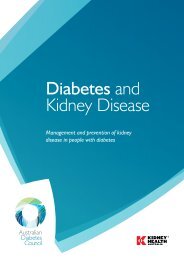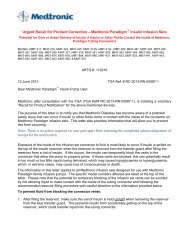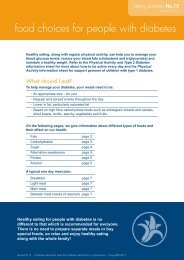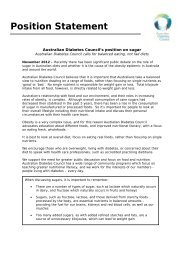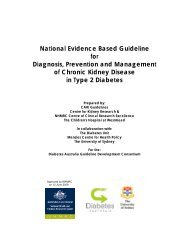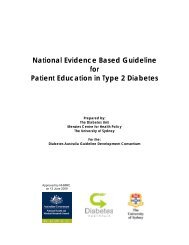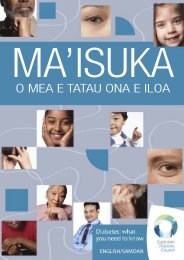Part 6: Detection and Prevention of Foot Problems in Type 2 Diabetes
Part 6: Detection and Prevention of Foot Problems in Type 2 Diabetes
Part 6: Detection and Prevention of Foot Problems in Type 2 Diabetes
Create successful ePaper yourself
Turn your PDF publications into a flip-book with our unique Google optimized e-Paper software.
Background - Peripheral Neuropathy as a Risk FactorFifteen percent <strong>of</strong> people with diabetes will develop a foot ulcer dur<strong>in</strong>g their lifetime(Reiber et al, 1998). Half <strong>of</strong> all non-traumatic amputations are performed <strong>in</strong> peoplewith diabetes (Pecoraro et al, 1990). <strong>Foot</strong> ulcers precede 84% <strong>of</strong> all lower limbamputations <strong>in</strong> diabetic people <strong>in</strong> the United States (Pecoraro et al, 1990). While thecause <strong>of</strong> ulceration is multifactorial, underst<strong>and</strong><strong>in</strong>g the ma<strong>in</strong> factors <strong>in</strong> the aetiology <strong>of</strong>the ulcer will <strong>in</strong>crease the likelihood <strong>of</strong> reduc<strong>in</strong>g ulceration <strong>and</strong> amputation despitethe ris<strong>in</strong>g prevalence <strong>of</strong> diabetes.In the UKPDS study damage to the peripheral nerves from prolonged hyperglycaemia<strong>and</strong> its metabolic consequences was present <strong>in</strong> 12.3% at diagnosis <strong>and</strong> <strong>in</strong> 30% after 12years <strong>of</strong> diabetes (UKPDS 33, 1998). The commonest form is a distal symmetricalpolyneuropathy with a glove <strong>and</strong> stock<strong>in</strong>g distribution <strong>of</strong> loss <strong>of</strong> sensation. Howeverthe loss <strong>of</strong> protective sensation is postulated to be the major factor <strong>in</strong> subsequentulceration. Coexistence <strong>of</strong> autonomic neuropathy can contribute partly by <strong>in</strong>duc<strong>in</strong>gdry sk<strong>in</strong> <strong>and</strong> foot oedema (Boyko et al, 1999). Muscle wast<strong>in</strong>g <strong>and</strong> foot deformityresult<strong>in</strong>g from peripheral neuropathy are also thought to contribute to the risk <strong>of</strong>ulceration. Severe peripheral neuropathy can lead to jo<strong>in</strong>t disorganisation fromrepeated trauma with loss <strong>of</strong> protective sensation result<strong>in</strong>g <strong>in</strong> a Charcot jo<strong>in</strong>t (mostfrequently the tarsometatarsal jo<strong>in</strong>t). The result<strong>in</strong>g foot disorganisation <strong>and</strong> deformitycontribute to recurrent ulceration (Sims et al, 1988). However it is also clear thatprecipitat<strong>in</strong>g factors are also necessary for the development <strong>of</strong> diabetic foot ulcers.Know<strong>in</strong>g the relative risk <strong>of</strong> peripheral neuropathy as an underly<strong>in</strong>g risk factor forulceration <strong>and</strong> amputation can help <strong>in</strong> target<strong>in</strong>g those with diabetes who are at risk<strong>and</strong> implement<strong>in</strong>g preventative <strong>in</strong>terventions to reduce subsequent ulceration <strong>and</strong>amputation (Shaw & Boulton, 1997).Evidence - Peripheral Neuropathy as a Risk FactorPeripheral neuropathy is associated with diabetic foot ulceration <strong>and</strong> amputationSeveral studies <strong>in</strong> people with <strong>Type</strong> 2 diabetes have related reduction <strong>of</strong> foot sensation<strong>and</strong> risk <strong>of</strong> ulceration or amputation.Copp<strong>in</strong>i et al (1998) reported the <strong>in</strong>cidence <strong>of</strong> foot ulcers or amputations <strong>in</strong> 405subjects without prior amputation attend<strong>in</strong>g St Thomas’ Hospital Diabetic Cl<strong>in</strong>ic. Therecords were exam<strong>in</strong>ed retrospectively, <strong>and</strong> 20 people who developed foot ulcer oramputation over the 14 year follow-up period were each matched with 3 peoplewithout ulcers. The population was 60% males with cases be<strong>in</strong>g <strong>of</strong> similar mean ageto the controls (50.5 v 50.1 years) however they had a much longer duration <strong>of</strong>diabetes (9.7 v 4.1 years, p=0.02). A raised VPT at basel<strong>in</strong>e was a predictor <strong>of</strong> footcomplications develop<strong>in</strong>g with OR 4.38 (CI 1.1-17.26, p=0.01).In 811 people with <strong>Type</strong> 2 diabetes <strong>in</strong> a community based cross-sectional study from37 UK general practices, neuropathy was diagnosed by cl<strong>in</strong>ical scor<strong>in</strong>g. Thepopulation was 50% males with a mean age <strong>of</strong> 65.4 years (range 34-90 years) <strong>and</strong> hada duration <strong>of</strong> diabetes <strong>of</strong> 7.4 years (range 0-50 years). Those with neuropathy were12




